David Holm Masterclass in Dhaka 2015
/Introduction
Between 25 September and 04 October 2015 a group of undergraduate architectural students from the University of Technology Sydney led by adjunct Professor David Holm visited Dhaka Bangladesh for a Drawing Masters class. The underlying intent of this Masters class was to observe via walking and define via drawing the public open spaces of Dhaka. The areas of Old Dhaka, central Dhaka and North Dhaka were visited on a number of occasions over a 9 day period. As part of this process a series of observations have been made on strategic developments that could be developed for the overall improvements to the urban conditions of Dhaka.
Old Dhaka
Retain urban layout:
The existing street configuration of old Dhaka is an organic configuration that has evolved over centuries. It is very worthy of retention in its current format and could be developed as a charming and engaging environment for living in and experiencing as a visitor.
Establish a world class sanitary plan:
Old Dhaka requires as a matter of urgency an agreed development plan to allow for the clean supply and removal of water and services throughout the complete precinct.
Ban private cars (rickshaws, 2 wheelers, 3 wheelers & service vehicles only)
This policy will allow the continued operations of old Dhaka to continue on a pedestrian priority basis and not to be overcome by private oversized vehicles.
Sanction green energy generation:
In unison with strategy a.(ii) the timing is appropriate to establish a green energy strategy that promotes the development of new format energy generation utilizing the abundance of solar exposure, the collection of water for use in varying formats, where possible the generation of wind generated power and overall the encouragement of waste recycling strategies.
Establish new ferry hub:
The current Sardaghat Ferry Hub is over congested and at its worst not meeting international safety standards. It is anticipated that a new world class ferry terminal facility would provide appropriate facilities for regional ferries, allow for the development of a commuter ferry system along the Buriganga River for people moving around the city to move along the river and allow a new public place and commercial opportunities.
These developments will place old Dhaka as a beacon of dense inner city dwelling formats.
b. Central green Dhaka:
Maintain urban layout and street configuration
The existing street configuration of central Dhaka was set out over 2 centuries ago. It is very worthy of retention in its current format and could be developed as a spacious and international environment for experiencing this cultural, educational, living and working sector of the city.
Maintain green spaces:
The city and especially central Dhaka is characterised by established green tree zones and extensive informal gardens as public places or as contiguous parts of campuses or cultural facilities. These amenities must be retained and maintained.
Establish below ground metro system:
An international quality underground metro system must be developed to service from the edges of old Dhaka, throughout central Dhaka, throughout new Dhaka and also including key points such as the airport, ferry terminal and redeveloped railway tod. This development will elevate Dhaka city to an international level, alleviate traffic congestion and allow an appropriate level of user amenity.
Encourage see through boundary edges:
The edges of the campus and cultural precincts referred to in strategy b(ii) above are often edged by high solid walls. These walls restrict vision into and around the spaces and should be removed to allow vision in a more egalitarian and harmonious use of the public spaces.
Develop main railway station as a transit oriented development:
The existing railway station should be retained and enhanced as a development that allows for the implementation of a high rise, high density transit oriented development concept.
These developments will allow central green Dhaka to be retained as the cultural and educational focus of the city set within unique tropical riparian landscape environment.
North Dhaka
Maintain urban layout and street configuration:
The existing street configuration of central Dhaka was set out over the last 50-75 years and is robust in its current format. Its retention and development as a spacious international environment is to be encouraged.
Maintain green spaces:
North Dhaka is characterized by established street section configurations of outer green trees zones and central roadway planting zones. These amenities must be retained and maintained.
Establish below ground metro system:
An international quality underground metro system must be developed to service from the edges of old Dhaka, throughout central Dhaka, throughout new Dhaka and also including key points such as the airport, ferry terminal and redeveloped railway tod. This development will elevate Dhaka city to an international level, alleviate traffic congestion and allow an appropriate level of user amenity.
Encourage see through boundary edges:
The edges of the residential and commercial precincts within new Dhaka are often edged by high solid walls. These walls restrict vision into and around the spaces and should be removed to allow vision in a more egalitarian and harmonious use of the public spaces.
Develop airport as an airport city concept:
The existing new airport is to be retained and enhanced to capture an airport city concept providing a focus for business development and international trade including convention exhibition centres, hotel and interchange facilities.
These developments will allow north Dhaka to be retained and refined as the upper end choice of living and working lifestyle, including the development of future business within overall Dhaka.
The overall aim would be the development of Dhaka Bangladesh as a unique and authentic Asian city experience focussing on the egalitarian benefits of its people and visitors.


